Every day, more businesses shift online. A few familiar names are stretching out a bit longer, and a few new players are entering digital for the first time. Big or small, whatever their industry, their aim is the same: to reach more people, work more efficiently, and continue to transform. With this new normal, a unified digital presence is essential. Customers expect fast, trustworthy experiences, and the quiet confidence that their information is stored safely, making e-commerce security and data encryption foundational, not optional.
As reach expands, so does the surface exposed to risk. A forgotten software patch or a weak login can create openings that no one expects. In today’s threat landscape, cybersecurity for e-commerce is crucial, as digital threats like ransomware and phishing, bot attacks, and other cyber threats in e-commerce have moved from rare events to routine challenges.
Strong security is about protecting relationships. It helps preserve trust, meet growing compliance expectations such as GDPR and CCPA compliance, and PCI DSS compliance, while keeping business momentum steady.
This manual has been composed to provide simple and effective steps that can easily be integrated into real practices. The intention here is to assist you in making the move with confidence, knowing that your ground is firm, thus ensuring that growth does not compromise stability. These are e-commerce cybersecurity best practices designed to protect your operations without slowing you down.
Digital Growth and the Expanding E-commerce Security Risk Surface
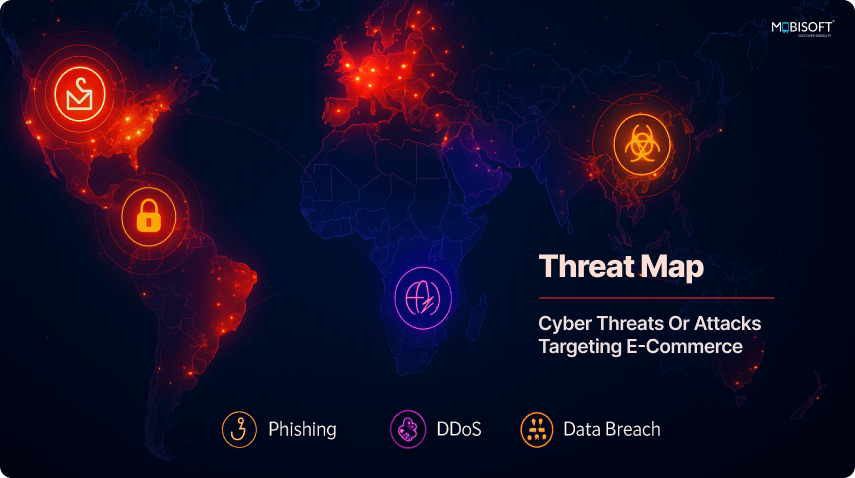
As more businesses shift online, the digital economy is growing fast around the world. India alone is expected to cross $1 trillion by 2030, backed by over 800 million internet users. From local brands in Southeast Asia to startups in Europe and marketplaces in North America, digital adoption is accelerating everywhere.
With this scale comes a new level of exposure. Security threats have become sharper, more frequent, and harder to spot. In 2022, India’s CERT-In tracked over 1.3 million cyber incidents, a signal of how real and relentless these risks are becoming globally. This further validates why cybersecurity matters in global e-commerce and highlights the need for robust cybersecurity solutions for e-commerce platforms.
Businesses of every size, across every region, are facing similar pressure. Whether it’s protecting online store security, ensuring secure access, or guarding against evolving threats, the stakes are high.
To meet this scale with performance and resilience, businesses often turn to trusted ecommerce development services that align with modern security needs.
Here’s a brief look at what many e-commerce players are up against:

While the threats differ by region, the core challenge stays the same: how to protect an online business from cyber attacks without slowing down growth. That includes safeguarding customer data, avoiding downtime, and enabling secure payment gateways for e-commerce. The first step is to see the landscape clearly, then prepare for what’s coming using practical, real-world defenses.
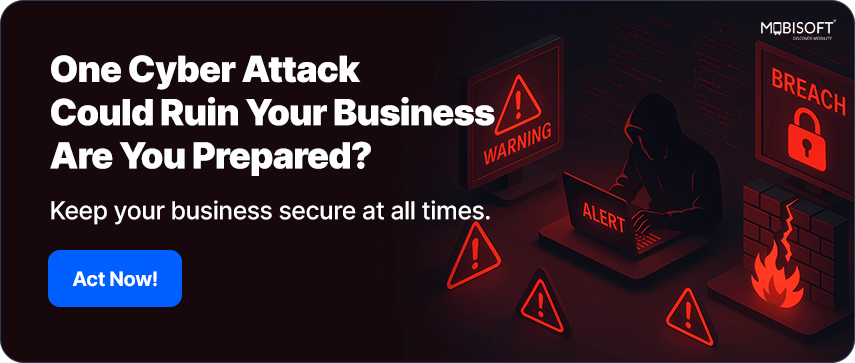
Why Cybersecurity for E-commerce Deserves a Front Seat in Growth Strategy
Guarding Customer Trust and E-commerce Data Security
Every purchase goes beyond the product. Customers hand over sensitive details, names, mobile numbers, delivery addresses, and payment credentials, assuming the system will guard them with strong ecommerce platform security measures.
Once that data slips, the damage spreads fast.
A PwC India survey showed that 83% of buyers would stop engaging with a brand after an ecommerce data breach. In global markets, we’ve seen the same trend: hard-won loyalty evaporates after a single slip.
E-commerce data security is about influencing retention, referrals, and long-term brand value. For teams building with limited resources, trust becomes a growth lever. Lose it, and acquisition costs rise sharply.
This requires a custom ecommerce platform security that aligns with both operational and compliance standards.
Navigating E-commerce Data Protection Regulations in India
In India, failure in ecommerce security compliance can attract penalties up to ₹250 crore per violation. But more than the fines, the real setback is reputational. No one wants to collaborate with a business under regulatory scrutiny.
Founders need to treat cybersecurity in ecommerce the same way they treat legal structure or accounting as a baseline hygiene factor. Without it, scaling becomes harder than it needs to be.
Getting Practical: Budget-Friendly Cybersecurity Solutions for E-commerce
Dispelling the Myth of High Costs in E-commerce Cybersecurity
Most business owners assume that ecommerce cybersecurity best practices require expensive tools or an in-house tech team. That’s where many stalls are. But in reality, basic ecommerce security solutions can be set up quickly and affordably, and block most threats.
For deeper protection models and advanced strategies, explore our cybersecurity solutions for businesses tailored for e-commerce environments.
These are small, surgical changes that act like digital safety nets:
Simple Cybersecurity Investments for Indian SMBs
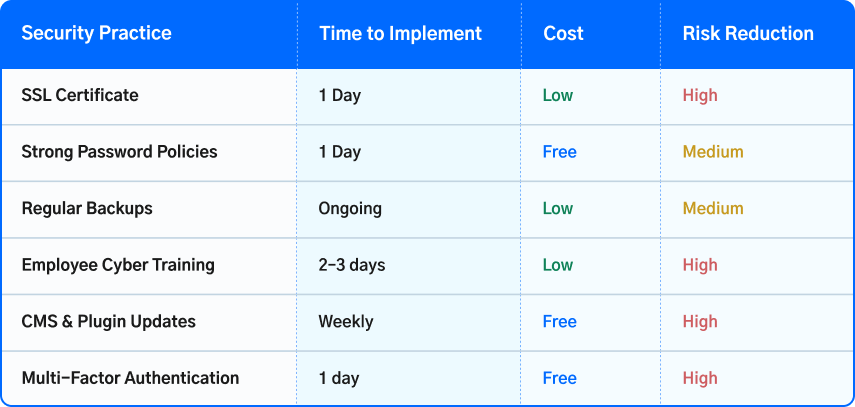
Most of these don’t need technical expertise. What they need is ownership, someone keeping an eye on e-commerce security hygiene.
Simplified Cybersecurity Roadmap for Indian E-commerce Businesses
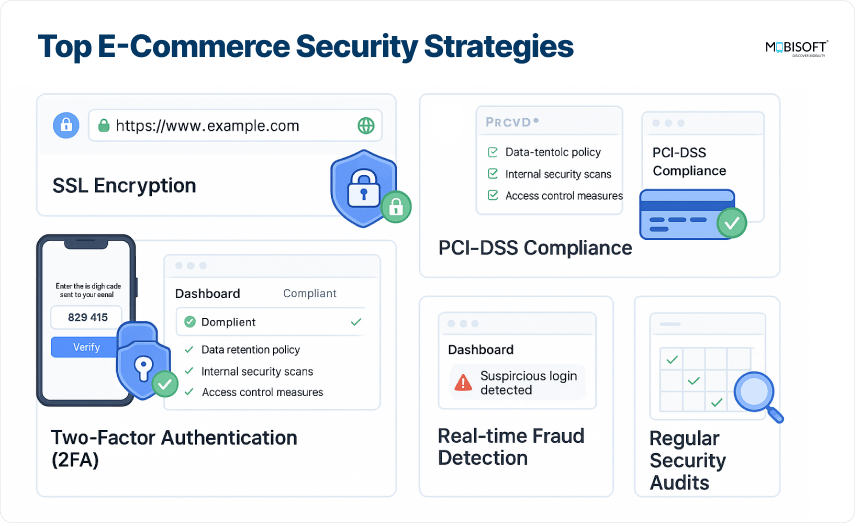
If you’re running an ecommerce business in India with a lean team, start with this playbook:
Use Strong, Unique Passwords
Make reuse a red flag. Rotate credentials every quarter
Keep Software Updated
CMS patches often plug security holes before attackers find them.
Train Your Employees
Even one team member clicking the wrong link can trigger a breach.
Choose Secure Payment Gateways
Prioritize to align with RBI, PCI-DSS, and ecommerce security standards
Backup Website Data Regularly
Store them across platforms, cloud, and local, in case you need a rollback.
Use a Web Application Firewall (WAF)
WAFs catch automated threats, bot traffic, and known exploit patterns.
Conduct Regular VAPT (Vulnerability Assessment and Penetration Testing)
Think of this as a fitness test for your ecommerce cybersecurity strategy
Security is a set of habits. For ecommerce founders aiming to scale, those habits pay dividends in uptime, trust, and operational sanity. Also, consider secure chatbot integration in e-commerce to manage customer queries safely without exposing backend systems.
Navigating Local Gaps, Global Moves: The Cybersecurity Equation
Spotting Everyday E-commerce Security Gaps in Growth Markets
Most breaches don’t begin with advanced zero-day exploits. They start with simple, overlooked issues, common across fast-scaling teams around the world.
From Nairobi to São Paulo, from Ho Chi Minh City to Warsaw, the pattern repeats: digital adoption outpaces ecommerce security infrastructure.
These are the weak spots that often remain open too long:
- Legacy software is still tied to customer-facing systems
- Devices without endpoint protection are accessing sensitive tools
- Admin panels are reachable through unsecured connections
- Weak or reused credentials across third-party services
None of this requires panic. What it demands is structure.
A short list. Consistent reviews. Clear ownership.
Quick Win
Turn on multi-factor authentication (MFA) today. It blocks a wide chunk of credential theft attempts without needing architectural overhauls. Most breaches start at the login. This shuts the door early.
Turning E-commerce Platform Security into a Business Edge
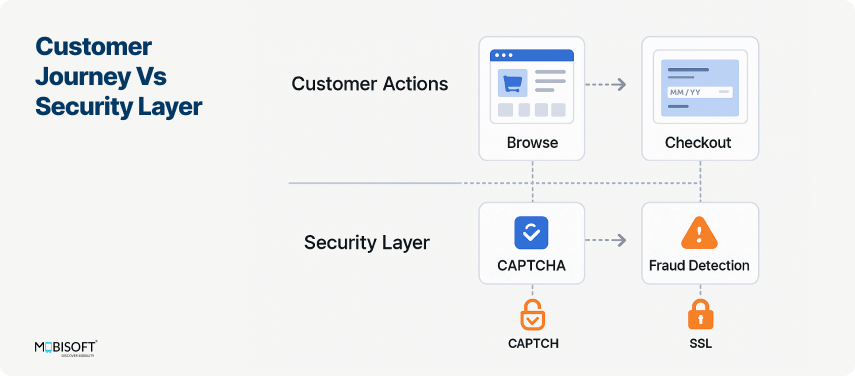
Global users now treat ecommerce platform security as part of the experience. It’s no longer invisible. A checkout page that shows SSL badges, payment compliance, and data protection policies earns more than trust it converts better.
Whether you're running an Indian ecommerce brand, a SaaS platform in Southeast Asia, or a DTC brand shipping globally, cybersecurity in ecommerce now influences:
- Bounce rates
- Abandoned carts
- Affiliate and ad network partnerships
- Investor confidence in due diligence
The smarter move? Turn your security layer into visible reassurance. Strong trust signals to reduce cart abandonment are directly linked to transparent and visible security practices.
How to show it matters:
- Use RBI-compliant and PCI-DSS certified payment gateways
- Display SSL encryption and security seals throughout checkout
- Maintain and share a public-facing privacy policy, updated with every product revision
- Add a “Your data is safe” explainer within the onboarding or payment flow
Customers know how ecommerce data breaches work now. They’ve seen brands crash from it. Being transparent about ecommerce data security reassures them that you’re serious about longevity.
What Security-First Growth Looks Like: Field Insights
What Security-First Growth Looks Like: Field Insights
Case Study 1: An online art marketplace
It was scaling fast, adding new SKUs weekly. However, fake listings and phishing attempts started to impact customer trust.
Here’s what they did:
- Set up a Web Application Firewall (WAF) for website security for an online business
- Trained team members on phishing recognition
- Commissioned a third-party VAPT (penetration test) every quarter
What changed in six months?
- Fraud cases dropped 45%
- Conversion rates rose during festivals due to better platform stability
- NPS (Net Promoter Score) jumped significantly after they publicized new safeguards
The company began exploring AI-based fraud detection in e-commerce to proactively identify high-risk behaviors
Case Study 2: A grocery e-commerce company
A grocery e-commerce startup was hit with ransomware and phishing. Entire operations froze. They didn’t wait for another hit.
Steps taken post-recovery:
- Rolled out endpoint security across all employee devices
- Automated daily encrypted backups to meet e-commerce data protection regulations
- Built a small internal playbook for security awareness
The impact:
- Incident response time dropped to under 60 minutes
- They landed three new regional partners, citing “security maturity” as a key reason
- Existing vendors reported higher trust and willingness to integrate systems
Conclusion: Building Resilient Growth with Cybersecurity for E-commerce
Cybersecurity for e-commerce anchors today’s business strategy, serving as the foundation for resilience and long-term stability.
As e-commerce gains ground, especially in fast-growing markets like India, staying ahead means locking in trust, preventing data breaches in e-commerce, and aligning with data encryption and GDPR, and CCPA compliance from the start.
Let’s recap:
- Protecting customer data earns long-term confidence
- Aligning with data laws avoids penalties and operational strain
- Small actions, SSL, team awareness, and regular backups shift the risk landscape meaningfully
Support sits closer than most think.
Tools built to scale, services designed for lean teams, and guidance rooted in real-world operations are already out there. Security also enables a secure personalized shopping experience, where users feel safe and understood
Start with what aligns. Stay consistent. Let cybersecurity carry the weight as growth accelerates.


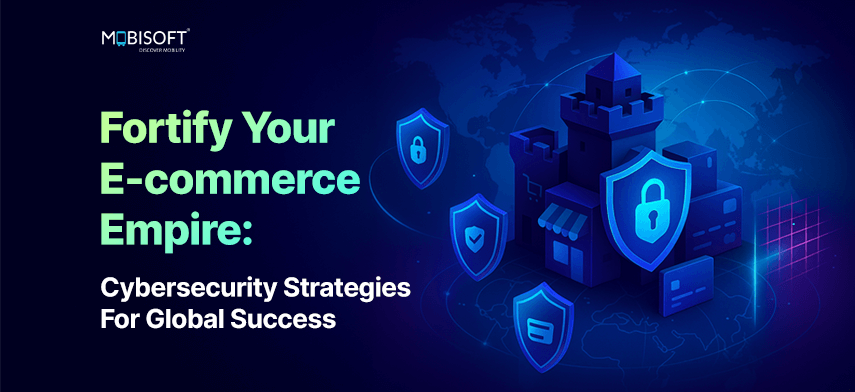


 August 1, 2025
August 1, 2025


